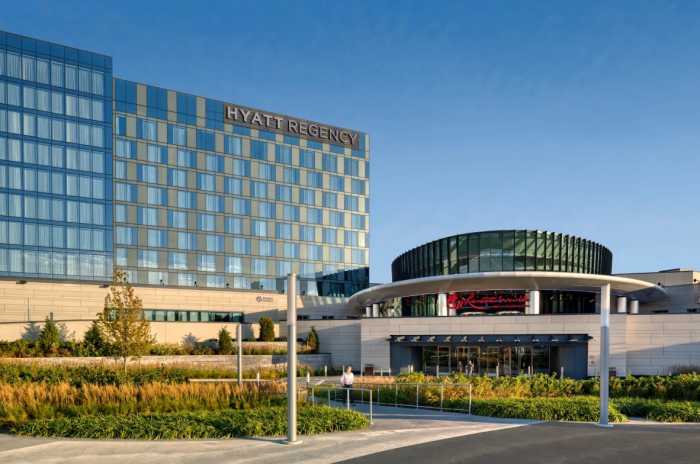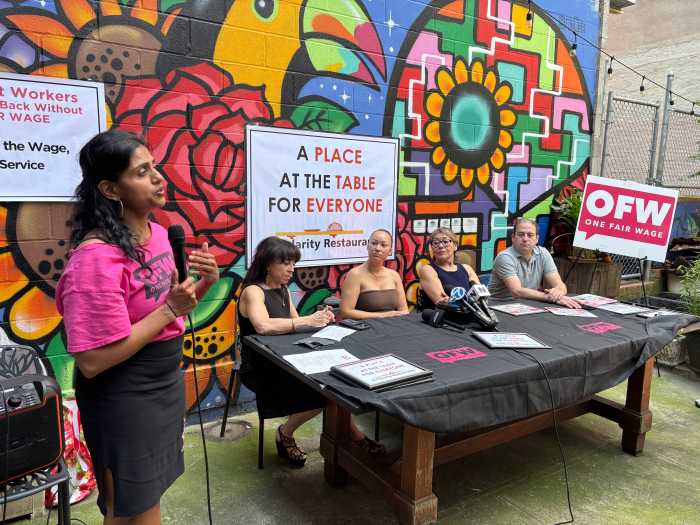A week after Wegmans Brooklyn opened, the Brooklyn Navy Yard’s Employment Center reported that it has broken a record by hiring almost 600 people for jobs at the industrial complex so far in 2019.
That is already a 28 percent increase from the number of hires in 2018 and the highest number of new recruits in a single year since the Employment Center was founded (in 1999), according to the report released by the Brooklyn Navy Yard Development Corporation.
The new employees joined some of the more than 400 businesses that currently exist at the Navy Yard and work in manufacturing, IT, business administration, design and more.
In fact, with the addition of Wegmans, 540 cooks, entry-level management chefs, entry-level management, full-time overnight workers, part-time bakers, and full-time customer service employees joined the Navy Yard community — the Employment Center was responsible for finding 214 of them.
About 90 percent of all the new hires at the Navy Yard are Brooklyn residents and more than a third of them live in public housing, the report states. About 18 percent have experienced long-term unemployment or were previously incarcerated. Four in five of them have a high school diploma, GED or less.
Earlier this year, the Navy Yard hit a major milestone, surpassing 10,000 jobs for the first time since the city took control of the sprawling waterfront campus in 1966.
That being said, the Navy Yard and its Employment Center have really been a boon to the community, according to Community Board 2 District Manager Robert Perris.
“We have a great deal of admiration for the effort the Brooklyn Navy Yard has taken as it grows and prospers so the residents of communities immediately around the facility benefit,” he told amNewYork. “And it’s not just this project. They had similar numbers when they developed Building 77.”
Perris said that the Navy Yard chose Wegmans for the redevelopment of Admirals Row because it requires a larger staff, is family-owned, and is “tremendously committed to promoting from within and developing its employees.”
“They spend a lot of money on training,” he continued. “This might seem somewhat intangible, but it’s not. These are the kinds of things make the community board proud of what the Navy Yard has accomplished and happy to have the industrial park in the community district.”
Jessica Hall, 23, started off as an intern at Amy Fronczkiewicz Photography in the months before graduating from Brooklyn College. The Flatbush resident connected with the Employment Center, which hooked her up with the photography studio. A year later, after Hall graduated, the Employment Center called with a potential job for her at New Lab — a center for frontier technologies.
“The Navy Yard is huge and there are so many tenants all doing different types of work — it’s pretty cool working here,” she said. “It’s a helpful tool for anybody looking for work or partnerships. The Navy Yard will help you pick your career or guide you to picking what you want for your future.”
Iku Ohashi, a longtime Brooklyn resident, also applied for a position through the Employment Center after learning about the Yard last year at Open House NY. He landed the job with Truebird – an automated micro-café company moving to Building 77 – and now works on their design team as a Sr. Mechanical Design Engineer.
“Working with the EC allowed me to connect to Truebird at the right time in their growth,” he said. “I’m excited to continue working on all of [their] cool products.”
As a nonprofit, the Brooklyn Navy Yard is able to focus more on its task as a landlord rather than making a buck, according to David Ehrenberg, the president and CEO of the Brooklyn Navy Yard Development Corporation. The organization gets philanthropic support from the Robin Hood Fund and the rent it charges to its tenants, which vary depending on the size and scale of each company.
“We really focus as a landlord … on the kinds of companies that can provide accessible, middle class jobs available to everybody in Brooklyn,” Ehrenberg said. “We are also able to attract those kinds of companies by setting rent at what those kinds of companies can afford — not what the highest rent payer might afford because those kinds of companies might not make those kinds of jobs.”
Another way the Brooklyn Navy Yard attracts companies that provide middle class jobs is by hiring local residents. Ehrenberg said studies have shown that when employees can walk to work, there is less turnover and better moral. Plus, it is just easier for an intern from Brooklyn, for example, to interview for a full-time job there moreso than a student from Boston.
It’s not just about the companies, however.
“We really want to make it clear that the development happening here is first and foremost going to benefit those who have lived here for many years,” Ehrenberg said. “The Employment Center is able to do the extra work to make it clear to locals — these jobs are for you and you have a fair shot at getting them.”
For information on how to work with the Employment Center and apply for a job at The Brooklyn Navy Yard, visit brooklynnavyyard.org/employment-center/for-job-seekers.





































